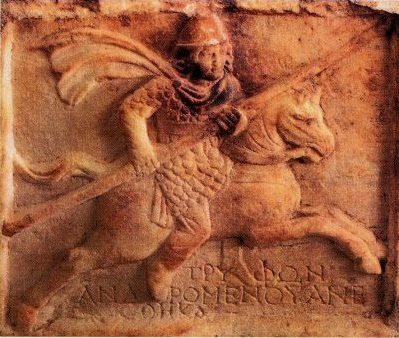
Alanian cavalryman, 1th- 2d century (1)
The ALANS

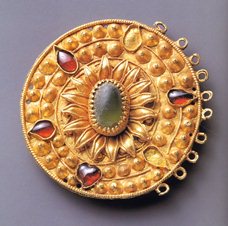
Fibula, 1th-2d century (2)

Alanian cavalryman, 1th- 2d century (1) |
The ALANS
|

Fibula, 1th-2d century (2) |
*
*
The OriginAbout the ancestors of the Alans many guesses are possible. We will review the various peoples that are eligible. TochariansIn the Tarim Valley on the western border of China are mentioned from the 2nd century BC the Seres, residents of Serica, the Silk Country. They are also called Tocharians. The Chinese called them Yuezhi. West of them lived the Wusun. From the beginning of the 2nd century BC they dominated the silk trade that ran over the Silk Road from China to India and Persia. 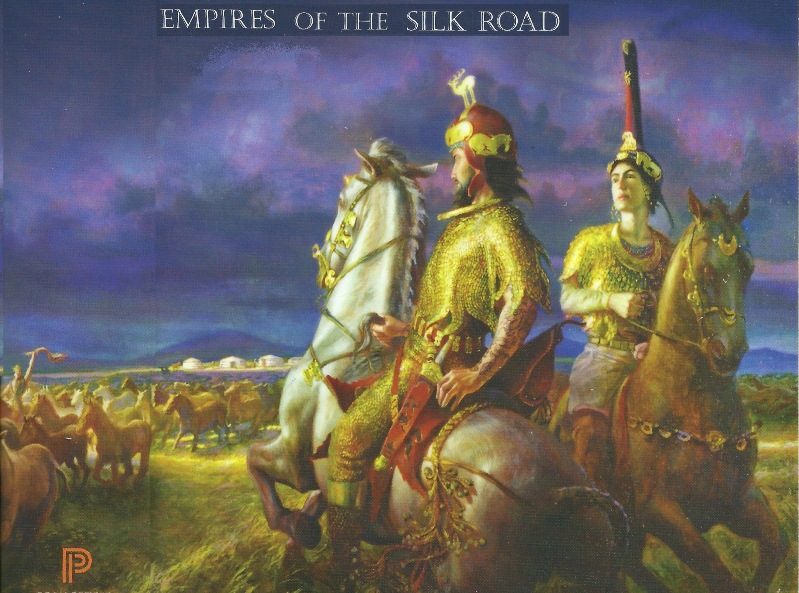
Leaders couple of the Nomads on the Silk Road. He has as a crest on his helmet a standing deer. (3) The Silk Road went through the Tarim Valley that was thought to be part of India. In later times this region was conquered by the Chinese and became the province Xian Jian. By the Western Peoples these province was mostly called East-Turkestan. (4) (5) |
|
|
In the Tarim Valley, north of the salt lake of Lou Lan are found mummies that are 3000 to 4000 years old. By the dry climate they are well preserved. They have an European appearance, are long, have a high nose, heavy beards, round orbits and mostly blond or reddish hair. They are buried in fine well preserved clothes. In one male mummy is found DNA. He had haplogroup R1a. On a mirror found in an burial site in Xinjiang, about 500 BC is found the figure of a dragon in the form of the letter C. This figure was in Roman Times the emblem Insignis, of the Taifali. A German tribe but good neighbors of the Sarmatian Iazyges. In the Roman Legions they were as allies, foederati, together stationed in a Roman legion in England. The Taifali lived in that time north of the Danube next to Sarmatia and in front of Pannonia, the most northeast Roman province. In Sarmatia lived since a century before the begin of our era the Sarmatian Iazygs. |

Mirror from |
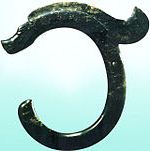
C-shaped jade dragon, Hongshan culture |
The C-shaped jade dragon is already seen in the Chinese Hongshan time (about 6700-4920 b.p.). This is the Chinese Legless dragon without wings and legs and with a pearl in his beard. It is a symbol of happiness and prosperity. It is plausible that the Indo-European population, that lived three millennia ago in the Tarim Valley overtook this symbol from the Chinese. |

Insignis Taifali |
|
The Tocharian (Tugrish) language, known in writings from 300 AD. is an Indo-European language. Their is a proximity of the Proto-Tocharian language with the Proto-Germanic language, more than with the Greek; Baltic-Slavic, Latin and Indian languages. It belonged to the so-called "North-Western group", North of the Carpathians. This dialect community, according to D. Adams, corresponds to the archaeological Globular Amphora culture, common in Eastern Germany, Poland, Galicia and Volhynia, as well as Romania and Moldova. After leaving this region the Proto-Tocharians had contacts in the first half of the III Millennium BC with native Greek speakers, perhaps somewhere in Moldavia. Then they migrated eastward through the Asian steppes, where they met representatives of Indo-Aryans of whom some were incorporated.They all together migrated East to the Tarim (Chinese Turkestan) incorporating several minor tribes. (6a) De Tocharians were semi-nomadic herds and hunters and the possibly forebears or a kinsfolk of the Yuezhi at the time of the Han-dynasty. Archeologic DNA shows R1a-M458 (7). YuezhiFrom the end of the 4th century BC began the Chines expansion probably as a consequence of overpopulation. Hereby were the initial peaceable nomad breeders de Hiung Nu or Xiongnu by us named Huns, driven to the West. Since 176 BC the Huns gradually expelled the Yuezhi westward. It is very likely that the Magyars were a group of them. They settled in Turgayskaya Oblast (Turgai) in Kazakhstan. The Chinese Han emperor Wudi sought in 138 BC the support of the Yuezhi against the Huns. Both were continuously attacked by them. The emperor built a great wall against the Xiongnu which until now exist. The greatest part of the Yuezhi moved further west. They went along the west side of the Himalayas and crossed the river Oxus, the present-day Amu Darya. these was the line of demarcation between the barbarian nomad peoples and the Greek-Hellenistic sedentary world of Persia. They established here the prosperous Persian Satrapy Sogdiana. They expelled the Parthians and killed their Kings. This territory lies on present-day Uzbekistan. They retained the dominance over the intermediate trade on the Silk road between China, India and the Middle East. The Kushan EmpireOne of the five tribes of the Yuezhi conquered in the first century AD the hegemony and founded the prosperous empire Kushana south of Sogdiana. During the height of their prosperity this country included North-India, Pakistan, Afghanistan and Bactria. In the north it bordered on Sogdiana. It existed till about the year 240. Then is was conquered by the Persian Sassanids. The KalashThe Kalash is a people that lives in the Hindu Kush mountains of Pakistan. Their physiognomy and religion is very different from that of the neighboring peoples. Many have remarkable blond hair and blue eyes. They are not Muslim or Hindu but retained their old faith. The Kalash are a genetically isolated population with a major admixture event (990 to 210 BCE) from a source related to present-day Western Eurasians, although we cannot identify the geographic origin precisely. This period overlaps that of Alexander the Great (356 to 323 BCE), whose army, local tradition holds, the Kalash are descended from, but these ancient events predate recorded history in the region, precluding confident interpretation. (7a). They are also potential descendants of the Yuezhi or other peoples from the North, Scythes or Saka. Their Y-DNA differs from the surrounding peoples and is related to the present-day Western Eurasians and also to the Iyer, Arier cast of the Brahmins in India. Till deep in the South at the Tamils in South India they share common genes. |
_-_c.jpg)
|
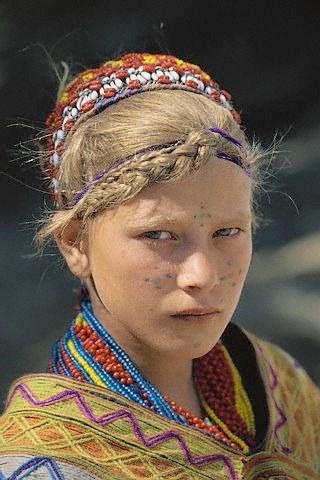
Kalash girl of Pakistan |
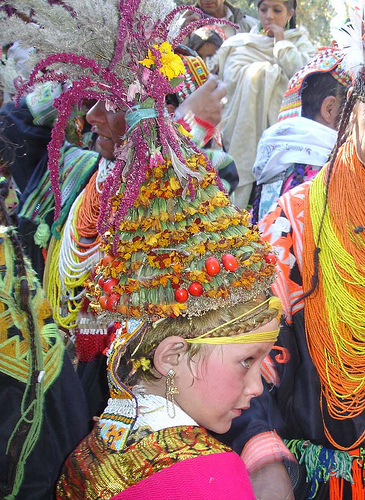
|
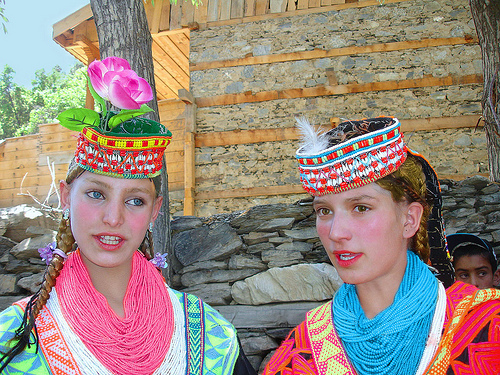
|
||||||||||
|
Girls from the Kalash in Pakistan in historic costumes The Treasures at the OxusNear the river Oxus many treasures are found in a grave with rich burial goods. It was found in 1880 and received the name Treasure of the Oxus. Most of it is now in the British Museum. Later followed new discoveries such as the Treasure of Mir Zakah, much of which is now in Japan. Recently is found the Treasure of Tillya-tepe. The Treasure of Tillya-tepeThis treasure is found in the tomb of a nomadic prince and his five women. Three of them wore typical Sarmato-Alanian jewels. They are buried at the same time in one tumulus but in five separate tombs. The burial moment can be dated on the basis of several coins in their graves. The youngest coin is struck in the middle of the first half of the first century AD.
* The first mentions as AlansThe Alans appear for the first time just before the beginning of our era in the Chinese and Persian annals. They spoke an Indo-European language but had no own script. Physical and cultural they looked like Sarmatians and their tales didn't differ much. Contemporary historians called them alternately Sarmatians or Scythes. They consisted of different tribes and probably they were not all of the same origin. Sometimes they incorporated defeated people in their group. The most eastern living Alans are described as having a somewhat Mongolic face. This was clearly a result of incidental intermarriage with Mongols. They were semi-nomadic breeders, mercenaries and merchants. De historian M. Ammianus writes round the year 350 AD that the Alans in former times were called Massagetes and that all peoples living north of the Black Sea are called Scythes. (9), and that they were located in the vast desolate expanse of Scythia, where they have subjected the people they met in victory after victory and have given to them their own name (as also did the Persians). The people of the Halani (whose here is no need to appoint the different tribes) thus consists of two groups, each in a different part of the area, but although separated and nomads wandering over a vast expanse, they have united over time under one name and they are called, because of their similar morals, barbaric habits and armaments, summarily Halani. (9a) Duros aeterni Martis Alanos, the hard, always fighting Alans, so are they named by the historian M.A. Lucanus in the begin of our area. (10) Strabo calls them As or Asioi (Asiani, lat.) but since the begin of our era appears the name Alan in old Turkestan toponyms f.i. Alan-Kalae (Fort of the Alans) and Kyrk-Alan. The Persian poet Ferdoűsî (941-1026) and the likewise Persian historian Al-Bîroűnî (X-XIe century) mentioned both that Alans, Aorsi or Asii in former times lived at the lower reaches of the river Amou daria. (11) In the Chinese literature they are mentioned in the Hou Han shu annals of the Chinese Eastern Han Dynasty (1st-3rd century AD), as residing at the boards of the Aral Sea, and that they first were named Yueh-zhi and later Alan-na. In the second half of the third century a big long wall was built by the Persian Sassanids, somewhat similar to the Great Wall of China but smaller. This wall was built from the Caspian sea to the mountains near Gonbad-e-Kavus, the Qizil-Alan. Later this wall is called Alexanders wall. He lies now in Northern Iran just below the border with Turkmenistan. At the same time groups As or Alans went to the west, where they by Flavius Josephus in the 1st century AD were observed at the lower reaches of the Don. It is not clear from where these Alans came. Two different origins are possible. Turkmenistan or the Land of the Seven rivers in Eastern Kazakhstan in Central Asia. In that country are in the writings of the Orchonin till in the 7th century residual Yuezhi mentioned under the name Az. (12) The Alans belonged to the best known and most glorious steppe peoples in the steppes of South Russia. They appear under different names. We see that some tribes bore names that are variations on the Indo-Iranian Arya what in the different dialects becomes Arraei, Areatas and Arii or by labdalization Alan. De Roxolans, Ροξολανοι (gr.), Rauxsa-Aryana (lat.), 'Brilliant Alans' lived the northernmost. They were also called the Royal Sarmatians. (13). Other names are Aorsi White Alans. Roman sources mention from the beginning of the 1st century that Alans occupy a large part of the steppes north of the Caucasus. Seneca in his tragedy Thyestes calls the Alans that live in the Danube region the wild Alans feris Alanis. Most historians see them as a Sarmatian people and think that the Aorses formed the core of the Alans. The writer Ptolomeus calls them Alanorsi. They provided with the Sarmatian tribe the Siraki support to the Romans in their fight against the Bosphorus King Mithradates III. So there are no clear cultural or ethnic differences between Sarmatians and Alans of that time, the Alans seem to be an more aristocratic military group. It is quite possible that the name Alans is used to give a collective name to a newly formed alliance of existing groups Sarmatians and is chosen for their common origin Arya, as genitive plural Aryânâm, just as exist in the name Iran, where by dialectical labdalization of r to l the name Alan was created. The ancient writers had no clear picture about this. Writing about the Parthian War in the year 35 the historian Tacitus names them Sarmatians, but Flavius Josephus calls them Alans. |
|||||||||||
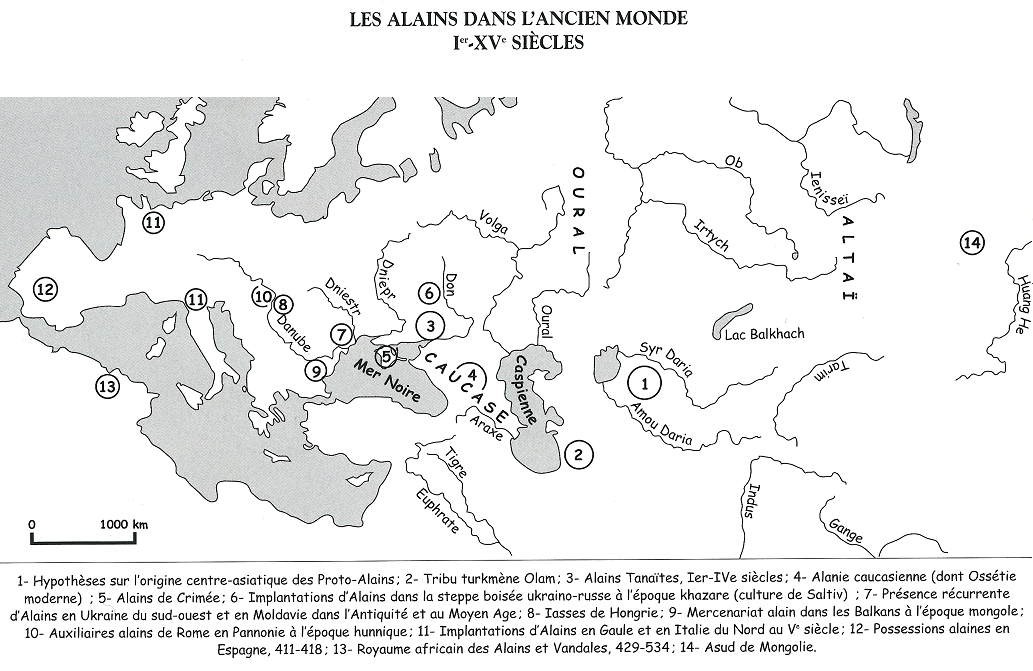
Map (in French language) from: Les Alains, Ie- XVe sičcles, Vladimir Kouznetsov and Iarosloav Lebedynski |
|
* The kingdom of the Alans at the DonThe first kingdom of the Alans was on the lower reaches of the Don. In later times this increased towards the south and in the first century AD they founded fortresses in the North Caucasus. In the South Caucasus laid the powerful kingdom of the Kartli. From that time the pass through the Central Caucasus was called the Dari Alan, the Alanian Gate, an indication that this fort was built to hold the Alans out. Later it was named the Sarmatian Gate. (14) The historian Seneca points out that only brave kings could afford to let the Caspian heights unprotected against Sarmatians. (15) The written history of the Alans starts at Western historians in 35 AD with their participation in the Georgian-Parthian war. They were known as the most formidable cavalry of their time and often they acted as mercenaries. They raided in Armenia and Media in the years round 72 in which they captured with a lasso the Armenian king Tiridates. With rich booty they returned. (15a) In 135 they are allies of the Georgian king Pharasmanes II against the Parthians and they threaten besides Parthia also Media and Cappadocia. Later, in 230, they fought together with the Parthians against the Sassanids in Persia. (16) They fought on horseback, whereby the princes and nobles, as well as their horses were protected by a hardened leather or metal hauberk that covered the entire body. They used their long swords with both hands and they did not use shields. On their helmets they often confirmed deer antlers. The deer played an important role in their mythology, it was a national emblem. The Roman historian Ammianus Marcellinus describes them as tall in stature and shapely, with blond hair, frightening even at moderately grim look and fast with their light weapons (17) They had a great ancestor cult but no shrines to worship gods. As a god they worshiped a sword stuck in the ground. There was little gender difference and probably more females than males were priests. Their deceased relatives were given beautiful tomb gifts, often of gold. they called their support in the fight. The worship of their finest sword, forged by Calybers, who were their best weapon smiths. 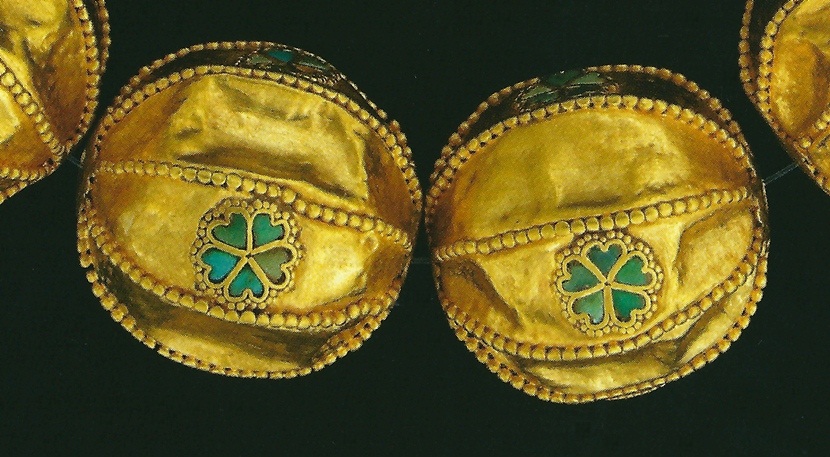
Detail of a golden necklace of an Sarmatian princess, Tillya-tepe, tomb VI, 1e century AD. (18) In the 3rd century came from the North an invasion of Goths who settled in the steppes of the Ukraine. The area of the Alans was as a consequence split in two. From now there were western Alans on the lower reaches of Danube, now Romania and eastern Alans on the lower reaches of the Don in modern Russia. In the west their living grounds were near those of the Sarmatians. Although the Alans were now divided into two areas and probably more, they remained till the 4th century an important people in the Eastern European steppes. A growing number of Alans went to the Caucasus mountains. In later times there emerged the medieval kingdom Alania. The residents of the present-day North Ossetia-Alania Republic pretend to be their descendants. The Alanian kingdom in the Crimea |

Tryphon, son of Andromenos, councilor at the court
|
For several centuries the Alans maintained their position in the Empire of the Bosphorus, the kingdom in the Crimea where they had took up a number of Goths,. The invasion of the Huns in 375 made this hegemony to an end. The Alans of the Russian steppes were attacked and expelled. A number joined in the ranks of the Huns and attacked with them the Goths. Another part of the Alans withdrew with groups of Goths behind the Djnester. (19) In the 5th century they keep fighting against Goths and Huns and became a vassal state of the Byzantine Empire. Alans served also in high positions in the Byzantine Empire. Two well-known are Ardabur and his son Aspar. |
|
The Alanian nobles were included in the aristocracy of this Empire. Ardabur became magister militum, general in the army (420) consul (427). Aspar became consul in 434. He also forged marital alliances with other prominent Byzantine families, as well as with leading families of the Goths. Aspar gained great influence in the politics of the Eastern Roman Empire and began to dominate it. He and his son Patriklos were king (basileus) of the Alans in the Empire. Patriklos was sometimes called the second emperor of the Empire. He fought together with Bonifacius against the Huns in Italy and the Vandals in Africa (468). Aspar arranged the accession to the imperial crown for Marcianus in 450. He himself was appointed for the throne in 1457 but refused and arranged for Leo I the ascent as Emperor. Aspars son Patrikios married a daughter of Emperor Leo I, Ariadne in 470 and became with that caesar, designated successor, to the throne. Aspar and his son were shortly thereafter killed in a palace revolution by the brothers of Ariadne. The Alanian kingdom of the CaucasusIn winter 557/58 the people of the Awars, about 20,000 in number, appeared on the border of the Alans, north of the Caucasus. The Alanian prince Sarosios then interceded through the Roman commander in Lazika (now in Georgia) with the emperor for their admission to the Roman Empire. The Caucasian Alanian empire extended in the sixth century from the northern slopes of the Caucasus to the Caspian Sea. The Alans had became sedentary, fortified villages and five towns arose. The population doubles from the 6th to the 9th century. They were divided into four distinct groups. From the 7th century is besides the name Alans also Asses or Osses common, particularly in the Eastern sources. The population structure is feudal with a marked noble class of landowners, whose leaders reach the level of kings with the title of Aldar as was used later in Hungary after the influx of Magyars. During The Byzantine Persian wars in the 7th century, they sided with the Persians. (20) The Khazar empireIn the northern neighboring people of the Khazars created an flourishing empire that lasted half a millennium. The elite had become Jewish due to the busy trade contacts with Jews, drawing in Jews from Mesopotamia and imperial Byzantium. There are indications that at least a number of Alans passed to Judaism. Khazaria collapsed in the 13th century when it was attacked by the Mongols and became weakened by outbreaks of the Black Death. The Judeo-Khazars fled westwards, settling in the rising Polish Kingdom and in Hungary, where their skills in finance, economics and politics were in demand. The Khazars hypothesis puts that their descent spread to central and western Europe and is now called Ashkenazis, and numbers for some 90 percent of the more than 13 million Jews in the world today. The Geographic Population Structure (GPS) tool is applied to the genomes of over 360 sole Yiddish and non-Yiddish speaking Ashkenazic Jews. This is the largest study of Ashkenazic Jews and the first one to study Yiddish speakers. Surprisingly, GPS honed in an region in northeast Turkey near Trabzon. There he found four primeval villages (one was abandoned in the mid-7th century A.D.) whose name may be derived from the word Ashkenaz, suggesting that this was the central location of ancient Ashkenaz. (20a) According to the so-called Rhineland Hypothesis, Ashkenazis descended from Jews who progressively fled Palestine after the Moslem conquest of 638 AD. and settled in southern Europe and then, in the late Middle Ages, about 50,000 of them moved from the Rhineland in Germany into eastern Europe, according to the hypothesis. But detractors say this idea is implausible. It would mean that the population of Eastern European Jews leapt from 50,000 in the 15th century to around eight million at the start of the 20th century. That birth rate would have been 10 times greater than that of the local non-Jewish population. And it would have occurred despite economic hardship, disease, wars and pogroms that ravaged Jewish communities. (20b) The Alanian medieval Christian kingdom of the CaucasusIn the years 1032-34 the Christian Alans fought against hostile Muslim nations. The country was strong under powerful kings who were related by marriage to the rulers of neighboring states. Borena, a sister of King Dorguleli, was married to Bagrat IV king of Georgia. Their daughter Maria married successively two Byzantine emperors Michael VII (1071-78) and Nicephoros III (1078-81) and went as widow into a monastery. The Alanian Princess Irena, married Isaac Komnenos, brother of Alexios Komnenos, Emperor of Byzantium (1081-1118). A unit of 600 Alans fought in 1071 with the Byzantines against the Turks and with 6000 men in 1074 against the Normans, but that last only a short time because they were bad paid. At the end of the 12th century begins the decay of the Alanian Empire. It was divided into several kingdoms. They shine still in 1154 while fighting in Italy for the Byzantine Empire. In 1185 they conquer the Empire Thessaloniki on the Normans and fight with the Byzantine emperor Isaac II against German Emperor Barbarossa. After the sack of Constantinople by the crusaders in 1204 and the expulsion of the Byzantine Imperial House, which their kings were connected by marriage, their influence comes to an end. The close ties with the Georgian royal family remained. Bordoukan, daughter of King Khoudan the Great marries Georgius III (1156-85), one of the greatest Georgian kings. Their daughter Tamar (1184-1213) was a powerful queen. She married in second marriage the Alanian prince David Soslan. Hereafter the decay begins. In 1236 a Hungarian monk describes the anarchy in the country many leaders in many villages and the kings are powerless. The Mongols under Genghis Khan plunder the country in 1222. Hereafter the country is divided into many parts. Cities are abandoned and there comes back a partially nomadic society. The last mentions of the Caucasian Alans dates from 1436. The Byzantine historian Laonikos Chalcocondyles stated them in still in 1463 as Christians with an own language and he praises highly their warfare and their gunsmiths. The following centuries they lead a unnoticed life and in the 18th century they came under the rule of the Russian Tsars. The Republic of North Ossetia-AlaniaAfter the Russian Revolution of 1919 their area is part of the Mountain Republic of the North Caucasus. In 1924 this becomes the North Ossetian Autonomous Soviet Socialist Republic. In 1990 the country becomes fully autonomous and is named North Ossetia-Alania. The old name was thus restored. For the connoisseurs this is some double, because Ossetia comes from Asen. (21) According to a census of the population of North Ossetia-Alania in 1992 they consisted of: Ethnic Ossetians: 63%, Ingusetes: 3%, Armenians: 2.5%, Russians: 23%, other groups: less than 10 %. Mercenaries in the Roman LegionsAlthough often mention is made about clashes between Romans and Alans this were only interruptions of long periods of quieter times with mutual trade and military co-operation. Sarmatians, especially Iazyges, once called Argaragantes (23), and Alans both those from the Danube region as Alans from the Crimea fought from the 2th to the 6th century in various ranks in the Roman legions of both the West as the East Roman Empire. They fought as Gentiles in small foreign military colonies, as foederati, allies, and as Comitatenses, imperial troops that escorted and accompanied the emperor on his campaigns. Some reached the highest ranks as praefectus, general, and one Alan reached under Valens, emperor from 369 to 374, the rank of magister equitum, commander in chief of the cavalry of a legion. That was Victor, a cautious and prudent man. (24) The Alans and also the Sarmatians wore in the legions their own weapons and banners. The Roman Emperors were recognizable by the droco standards beard by their escorting Sarmatian elite corps, heavy armed cavalry with their body covered with thin metal discs that complied their corpses with so great coherence that their armour remained perfectly fitting with every movement, the classic Sarmatian outfit. Emperor Julianus adopted as Caesar the purper draco banner that blowed on the top of his lance with a tail of a shed snake skin. (25) The last mentioned Alanian regiment in the Western Roman Empire was in Ravenna in 487 nine years after the deposition of the last Western Roman Emperor. Like the Sarmatians the Alans had also small colonies in the Po Valley. They took part in the election of the Ostrogoth Odoacer to Roman Emperor and later they served in his army. See more about Alans and Sarmatians as mercenaries in the Roman empire at: Sarmatians as gentiles. About the stationing of Alans in the Empire is a document the Notitia Dignitatum preserved, composed under emperor Honorius (395-423). It mentions twenty four prefecturae of Sarmatians, of whom seventeen in Italy and six in Gallia. In Velay was een prefectura of Sarmatians and Alans and near Poitiers of Sarmatians ans Taifali. In Engeland was a prefectura near Ribchester (Lancashire). De list is incomplete surrendered. The prefecturae in Germania secunda are lacking. |

|
On the left the emblem of the Taifali. This figure is seen for more than 1500 years on pottery of the Tocharians from the Tarim Valley in former East Turkestan, modern Chinese province Sinkiang, witness the drawning of prof. Mei Jianjun from Beijing, the possible forebears of the Alans. On the right that of the Alans. |

|
|
The war cry or battle cry of the Sarmatians was Marha Marha. Under the proclamation of this cry threw a Sarmanian soldier once his boot in the face of Emperor Constantius, while he in 335 was giving a speech in Pannonia to unsatisfied Sarmatian warriors (to less paid). The emperor then no longer knew whether he was commander or an ordinary foot soldier, and thought his last hour had beaten. He fled and no guard could prevent that the imperial seat with cushions embroidered with gold was captured by the mutineers. Afterwards there was only a small punitive expedition because the emperor had to return urgently to Sirmium. (26) The first large contingent Sarmatians in the Roman Army is the cavalry stationed in Britain from the end of the 2nd century. Among them is a large number that Marcus Aurelius had agreed in a treaty in 175 AD with the Iazyges. Of the 8000 horsemen was a contingent of 5500 sent to England, divided into Alae of 500. It is not known whether this was intended as a temporary secondment but part of them settled there with women and children. The Sarmatian old myths and legends, the Narts, life on to date in England and also in northern France. |
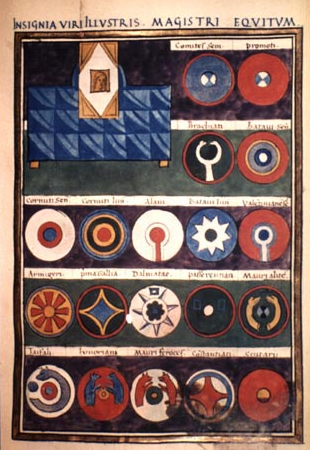
Distinguishing signs of the foreign cavalry.
|
Sarmatians wore in the Roman army,their own weapons. They were good in forging. In the Caucasus the oldest armories are found. Here lived the Alanic tribe Calyburs. who were known for their ironwork. It is possible that they have introduced the metalwork in Europe or at least have contributed to it. In 401 Alans participated in the battle of Stilicho against Quaden, Vandals and Marcomanni from the other side of the Danube. In 402 the Alan Saul fought with the Romans against the Goth Alaric in Pollentia. He was killed in that battle. Groups Sarmato-Alans were installed as foederati round 455 south of the Danube in Scithia Minor under their leader Candac. The emperor Maiorinus, 457-461, used Alanian and Sarmatian troops in battles against the Vandals in Africa and after the defeat they were disembarked in Gaul, where they will have been recruited. They began to plunder presumably for non-payment and invaded in 462 northern Italy under their king Beorgor. |
|
After the time of the Huns remained Sarmatians in the Hungarian plain. In 470 was the last known raid of the Huns under their leader Babai. Hij crossed the Danube and invaded Pannonia Secunda and conquered Singidinum (Belgrade). The East Roman Emperor Leo I sent Theodoric, the later Western Roman Emperor, who killed Babai. The last mentioned Alans corps in the Western Roman Empire was in Ravenna in 487, nine years after the deposition of the last Western Roman Emperor. Like the Sarmatians the Alans had colonies in the Po Valley. They took part in the election of the Ostrogoth Odoacer to Emperor and served in his army. In 568 some Sarmatians of the Danube followed the Lombards and participated in the conquest of Italy and settled in small colonies in the Po Valley. |
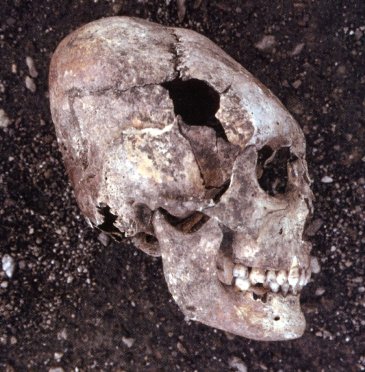
Deformed skull by bandage in youth, 4th century,
|
|
In graves in Valais (Zw.) 5th century, and Valence (Fr.) 4th century, skulls are found, the same as found in the Ukraine, with the characteristic skull deformation, caused by tight bandage of the growing skull of new born babies as seen at the steppe peoples as Sarmatians. (29) |
|
The necropolis of Obernai (Alsace, Bas Rhin, France) is one of the few important groups discovered in France and it demonstrates for the first time the treatment of an Eastern community in Alsace at the end of the Roman Empire. These Merovingian necropolis consists of eighteen burials oriented west/east. Three contained silver earrings. One contained two small gold pins on the chest of the deceased, which may have fastened a garment such as a veil. A chatelaine was connected to a belt with various objects attached including a silver mirror, similar to those used by the Alano-Sarmatian populations of the Caucasus, a tweezer set and several large coloured glass beads and amber. This female also had a triangular antler comb, decorated with geometric motifs and horse heads at either end. |
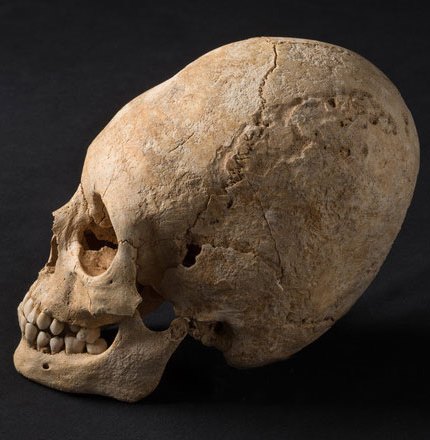
Distorted skull, necropolis in Obernai, Bas-Rhin. (29b) |
|
Besides the grave goods, the eastern origin of the individuals is attested by the presence of an intentionally deformed skull. Burials such as this have been discovered in isolation in northern Gaul, Germany and Eastern Europe and often include rich furnishings. They would appear to represent the graves of dignitaries and their families who were incorporated in to the Roman army at the time of the great migration. (29a) After their military service mercenaries got land and were usually settled where they had served. It is possible that they introduced the metalwork in Europe or at least there have contributed. They were probably permanently admitted at the invitation of local rulers. Many Alans immigrated into Italy and were placed together. (30) 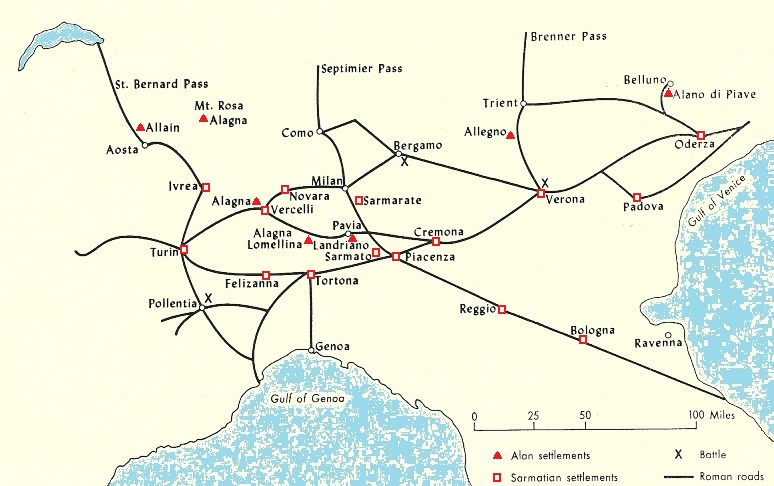
Locations of Sarmatians and Alans in Northern Italy. (31) THE MIGRATION PERIODThe invasion of the Huns that happened round 375 had major consequences for the resident populations. The Eastern part of the Alans withdraws to the south in the Caucasus and settles in the kingdom of Alania, nowadays the Republic of North Ossetia-Alania. (32) A part of the western group of Alans joins the Huns after a battle in which many were killed and then fight with them half as vassals half as their allies. Some groups of Alans went in Roman service and form the comitatus Alani, an cavalry division of the imperial army led by an own leader the magister Equitum. They protect the emperor on his campaigns. In 359‑408 they fight with the Roman general Stilicho in northern Italy against the Huns. (33) The Alans who remained in Pannonia were driven westward by the Huns. They moved along the Danube to the Rhine and met there the also expelled Vandals, Burgundies and Sueves (Quaden). 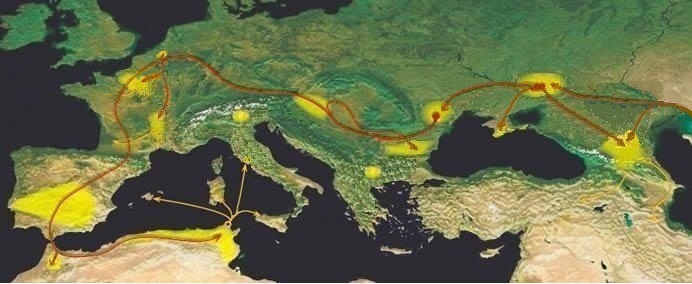
The migration of the Alans during the great migrations in the first centuries AD.
At that time the Roman garrisons which had the task to guard the limes at the Rhine were largely recalled to Italy to resist the Goths. Only small units of Frankish foederati whom Stilicho had instructed to guard the border were left. The massive group of peoples crossed the Rhine at several places near Mainz and Worms and invade the Roman Empire at 31 December 406 despite fierce opposition of the Franks, who fiercely fought especially against the Vandals. The Alans saved these from destruction and were rewarded for this some years later when they were supported by the Vandals in a fight against the Goths that they were about to lose. DIVISION OF THE WESTERN ALANS INTO TWO GROUPS,Then the Alans split into two groups. One group goes forth under king Respendialis while, as some say, plundering Gaul. The other under King Goar place themselves under the authority of the Romans. RespendialisThe Alans under Respendialis move on with the Vandals and Suevi through northern Gaul along settlements that later became the cities Strasbourg, Reims, Amiens, Arras, Boulogne sur mer, and Tournais. Especially the vandals left, according to some sources, a trail of destruction behind. They roam three years through the Gallic province of Germania Secunda, located between the Rhine and the North Sea. Until the spring of 409, they seem to have focused mainly on the Northern Gallic provinces of Belgica I and II and Germania I. In 409 they move to Spain where they are invited as auxiliaries by the Roman general Gerontius, a friend of Respendialis. He was in revolt against the Roman usurpator Constantine III. Gerontius was then killed in 411 during a battle in Arles despite strong defense by his Alanian friend. In Spain arises now a power vacuum. The Alans, Vandals and Suevi then decide to invade the Iberian Peninsula and divide it among themselves and they established their kingdoms there. The kingdom of the Alans in IberiaThe kingdom of the Alans stretched from the Atlantic Ocean in Portugal to the Mediterranean Sea. In the province Valladolid, region León, is a village called Villalon de Campos, which is thought to be founded by the Alans. (34) In 418 they conduct a battle against the Roman armies who want their expulsion. These troops consist primarily of Gothic auxiliaries. The Alans are suffering very large losses. They are saved by the Vandals and then join them. These were the previously by the Alans saved Vandals in Gaul. In 422 the Vandals and Alans conquer the southern port cities and they grab a large naval fleet. The kingdom of the Vandals and the Alans in AfricaThe Vandal Geiseric (34a) founded in 428 the kingdom of the Vandals and the Alans. He decides to cross to North Africa and conquers in 430 and the important capital and port town Hippo. The Eastern Roman emperor sends a fleet led by general Aspar, an Alan by birth. He fights them without success and concludes to a peace treaty in 435 in which the kingdom of the Vandals and Alans is recognized as a country with Hippo as capital. After the departure of Aspar king Geiseric wins the historic city of Carthago that from now is the capital. They also have now a huge fleet. 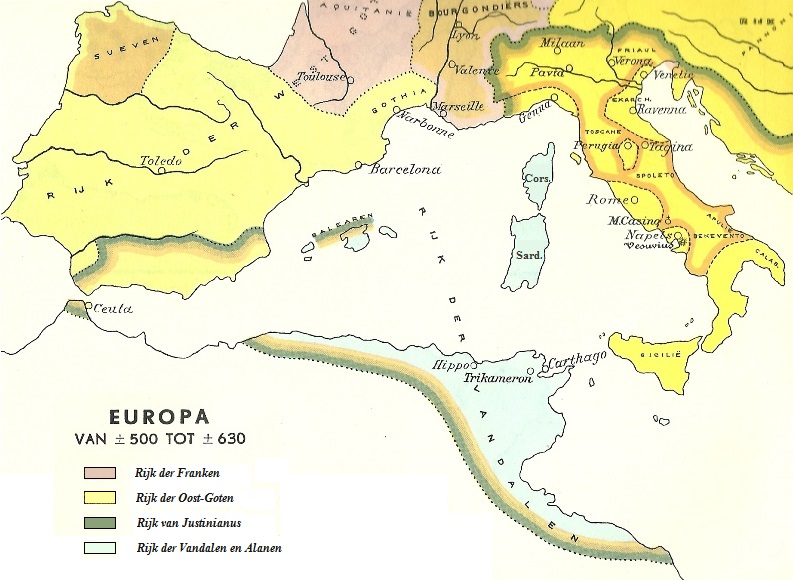
Europe from 500 to 630. Here you see the Empire of the Vandals and Alans in North Africa, Sardinia and Corsica. Map from the Great Dutch Historical School atlas. The Alans integrate into the Vandal population, as they had done in Gaul with the Franks. From now this is over more than a century the most dominant kingdom in the Mediterranean. In Africa, the present Tunisia and Algeria, are fertile fields that since a long time supply the grain for Rome and Italy. They will conquer all coasts and islands in the western part of the Mediterranean included the islands Sardinia, Corsica, the Balearics and Sicily. This empire is during the reign of Geiseric, during fifty years, the most powerful kingdom in this region. They also dominate great parts of the mainland of Italy, Greece and all the Greek islands. At a very old age dies in 477 king Geiseric. In Sardinia, he had established a reinforcement against invasions from the north and put there Moorish settlers with their families. It is due to its high rocky coast a natural fortress. By Rome it was used for a long time as a place of exile of troublesome citizens. The indigenous population was divided into two factions, farmers in the villages and nomadic shepherds in the mountains, which were called barbarians. The church built here many monasteries. Under his successors, their power will slowly wane. The island of Sicily they lose already while in 480. The empire endures till 534. Hereafter it is incorporated into the Byzantine Empire. Their former towns on the Iberian Peninsula that were overcome by the Goths live on under the name Got-Alania now Catalonia. (35) GoarGoar offers his services as foederatus of Rome and got the order to keep the area of Germania secunda clean from other invaders. Therefore he goes to Colonia Agrippina in Germania secunda and settles there. At that time the Burgundians who were first located on the Mid Main entered Gallia and they also offered their services to the Romans and got the same order. It is there - and not in Germania Prima, in the region of Worms, as always is mentioned, that Gondahar (Gunther) founded the kingdom of the Burgundians. (36) The power of the emperor weakens during the following years so fast that in 411 Goar and the Burgondian king Gundahar, proclaim at Mundiacum in Germania secunda the Roman aristocrat and general Iovinus as emperor. Where Mundiacum was is uncertain. Most eligible is present Müntz, gem. Titz, Julich, Deutschland, near Colonia Agrippina, at the via regia from Colonia Agrippina to the Tungri. Half the way current Köln and Maastricht. (37) The opinion that this event took place in Mainz is incorrect. This place was formerly Moguntiacum and laid in Germania Prima. The Burgundians were somewhat later stationed here and then it became an important centrum. (38) From this time, in the fifth century, date the events recounted in several epics as the Edda and the Nibelungen. The epic of the Nibelungen is first recorded in Passau on the Danube around the year 1200. It recounts the heroics of the Dutch hero Siegfried (Zegevrijt) of Xanten, who defeated the snake dragon (Ribbon Dragon) and by the bath in his blood had become invulnerable. After that Siegfried conquered the land and the treasure of the Nibelungen on the edge of his empire to Xanten. The ribbon dragon seems to be a metaphor for the dragon, the wing- and legless dragon that the Sarmatians carried as standard and field character. Sarmatians were in that time encamped at the Rhine. Regarding Nibelungen is thought to Niviella the current Nivelles. Siegfried went to the court of Gundahar, king of Burgundy at Worms to marry his Sister Kriemhilde. The father of Gundahar was king Dankwart and an influential uncle was called Hagen of Tronje, which is akin to Traiana, another name for Castra Vetera located near Xanten. The domain names indicate an origin of Burgundians and Nibelungen from the region of Xanten and Castra Vetera. Here was Mundiacum. Subsequent they went to Moguntiacum, in Germania prima, modern Mainz, at the Middle Rhine. In the saga is mentioned the city of Worms instead of Mainz, probably because it became in later time more important. (39) 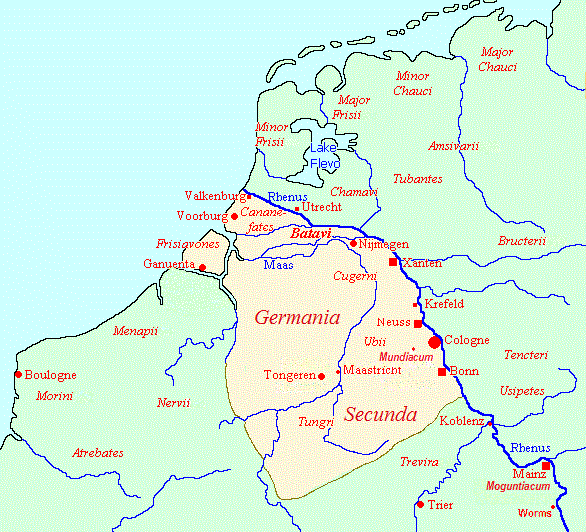
The Roman province Germania Secunda Goar and his followers continue to support the Empire, even when Iovinus after two years is already deposed and slain. In 442 Fl. Aetius, the Roman commander in Gaul requests Goar ‑ probably a son of the last taking into account the time span ‑ to come to Orleans and hold under control rebellious natives and the there present Visigoths. Goar establishes his Capital in Orleans. His successors took later in possession the estates in the region between Orleans and Paris. Many places in that regio bear now names of Alanian origin. King Sambida accepts in 440 a settlement at Valence and king Eochar got from the bishop of Auxerre in 447 his own country in Brittany. In an area around Lake Geneva there are so many places that bear Alanian names that they must have been of Alanian origin. Here are also graves found with the typical skull deformation of the steppe peoples. Sangiban the successor of Goar fights together with the Visigoths and the Roman general Aetius in 451 on the Catalaunian fields against the Hun Attilla. In the course of this century the Alans are often mentioned at wars in Gallia Cis and Trans Alpina under king Saul. He got the high Roman function of praefectus. After that time is no longer heard of Alans. It is obvious that after the collapse of the Roman Empire the Alans, Burgundians, Visigoths, and Huns together with the remaining Romans are absorbed in the native Celts population. It were only the Franks and the Burgundians who founded their own empires An example of this assimilation may be the appearance of the first name Alain. This name became very popular. The same as with the name Goar. We see in the sixth century a bishop called Goar and the saints St. Alanus and St. Goar. A variant name is Eochar. The Ossetian equivalent is Ićukhar. Another Goar was in the year 627 in Aquitaine Count of Albi and succeeded as bishop of Metz in 630 St. Arnulphus, the oldest known forebear of the Carolingians. This could be an indication of a family relation. 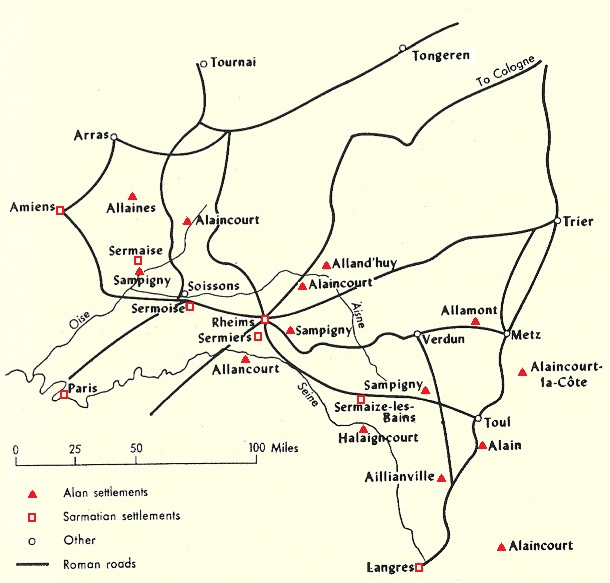
Settlements of Sarmatian and Alans in North-East Gallia. (40) There are many places in France with names as Alaincourt, Alland'Huy, Aillainville, Sampigny, Sermaise etc. that remind Alanian settlements. |
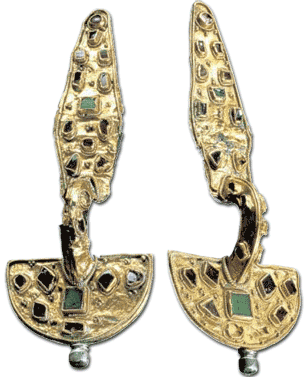
|
In Normandy in the Calvados are found in 1876 near Airan some graves dating back to the 5th century. These tombs are close to two former Roman camps that were part of the defense line against Frisian and Saxon barbarians. The richest grave concerns a young woman with jewelry that is partly of German and partly of Roman origin and partly equivalent to contemporary grave finds in the Burgundy in Balleure in the Elsas at Hochfelden, in Germany in Fürst and Altlußheim in Austria in Untersiebenbrunn and in Portugal at Beja, and also is very similar to jewelry found in the Alanian Kurgan of Loutchistoďe in Crimea. This is probably the tomb of the wife of an Alanian army commander. (41) A pair of golden Fibula with polychrome stones from a presumed Alanian grave in Normandy. (42) |
|
* Jasz in HungaryA tribe of nomads who spoke an Sarmatian-Alanic language, resembling the Ossetian, and called themselves Alans was mid 13th century allowed by king Béla IV Árpád to enter Hungary. They had to fight the Mongols and did that succesfully. They came from South Russia and are called Jasz, probably in memory of the Sarmatian Jazygians who had a same kind of language and lifestyle and lived here eight centuries ago. They settle in the central part of the Pannonian Plane, former Sarmatia. This region is now called Jászság with Jászberény as most important city. The following centuries they merged in the population. Their langauge disappeared but there is a dictionary of their language preserved. * DNAThe historian Ammianus M. writes about the year 350 that Alans lived in Scythia. In the course of time they had united with other peoples. They consisted of two groups and all were designated as Halani. (50) Today, it is increasingly clear that Scythians and so Alans and Sarmatians had the Y-DNA haplogroup R1a. Archaeological remains of an old Sarmatian skeleton in Nadezhdinka, Volga Steppes, Samara Russia dated 380-200 bce is R1a1a1b2a2a-Z2123. (51) We have 5 sequences from ancient Scythians. Three are R1a1a1b, one R1b1a and one Q1a. (52) Most DNA from burial grounds in South Russia is R1a1a, only in six human skeletons from burial mounds in the Don region north of the Caucasus from late Neolithic time have G2, in depth has not been tested. (53) Haplogroup N is mentioned in eastern Sauromatians by Chang Hua'an, 常華安. (54) In the Caucasus the Y-DNA haplogroup G2a1a has the highest concentrations in the world. More the 50% of the men come for this. The highest concentration is in North Ossetia-Alania. They pretend to be of Alanic origin, but this is never proved. Increasingly is assumed they live there since the beginning of the Neolithic and came from the south. In the Hungarian Magyar Y-DNA Project of FamilyTree DNA some more then 530 men were tested till the year 2019. About more then half of them have Haplogroup R, more then a quarter have Hg I. Hg G has a somewhat higher percentage then the European average, here 6,8%. Haplotypes that are compatible with the samples seen today in North Ossetia-Alania are visible in 9 samples, less then 2%. (43a) |
|
To write this article, a number of recent and classic works were studied. (55) This is the translation of a Dutch web page.
|
*